|
|
|
Sort Order |
|
|
|
Items / Page
|
|
|
|
|
|
|
| Srl | Item |
| 1 |
ID:
152107
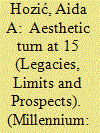

|
|
|
|
|
| Summary/Abstract |
Roland Bleiker’s article ‘The Aesthetic Turn in International Political Theory’ appeared in this journal in December 2001 as part of a special issue on ‘Images, Narratives and Sounds’.1 The article drew a line between mimetic approaches to international relations, which did not ‘pay enough attention to the relationship between the represented and its representation’, and aesthetic approaches, which directly engaged ‘the gap that inevitably opens up between a form of representation and the object it seeks to represent’.2 Arguing that ‘representation is always an act of power
|
|
|
|
|
|
|
|
|
|
|
|
|
|
|
|
| 2 |
ID:
138518


|
|
|
| 3 |
ID:
172224
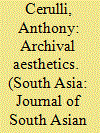

|
|
|
|
|
| Summary/Abstract |
Can the Indian manuscript and manuscript library be art? In what follows, I reflect on this question by examining a set of photographs I created for an art project called Manuscriptistan. I explain what it has meant for me to aestheticise Indian manuscript libraries and manuscripts, and I offer some insights about why it is important for scholars to bring sensual, spatial and artistic awareness to the things with which, and the spaces in which, they do their research.
|
|
|
|
|
|
|
|
|
|
|
|
|
|
|
|
| 4 |
ID:
187620
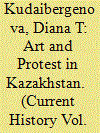

|
|
|
|
|
| Summary/Abstract |
Recent events in Kazakhstan show that political art has the potential to be a potent form of protest in some of the most authoritarian states in contemporary Central Asia. After the collapse of the Soviet Union, artists in Kazakhstan and elsewhere in the region began turning away from the canon of Socialist Realist art, with its sole aim of serving the regime and depicting its visions of the future. New forms of contemporary art emerged, drawing sharp contrasts with official art in form, content, and culture, as more artists insisted on freedom from state patronage and control. In the political upheaval following the resignation of long-ruling President Nursultan Nazarbayev, artists have inspired protests with pointed critiques.
|
|
|
|
|
|
|
|
|
|
|
|
|
|
|
|
| 5 |
ID:
127848
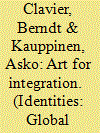

|
|
|
|
|
| Publication |
2014.
|
| Summary/Abstract |
Cities increasingly use artistic and cultural activities to promote active citizenship and social cohesion. We suggest that city-sponsored cultural and artistic practices in Sweden are finding a new discursive context in migration. In this article, we look at two artistic and cultural institutions in Malmö, Sweden: Arena 305 and Drömmarnas hus. We develop a typology of governmentalisation based on the work of Nicholas Rose and Peter Miller, which allows us to describe the governing activity of Arena 305 and Drömmarnas hus. What becomes visible is the discrepancy between the moral form of the political rationalities and the technologies of government: even though institutions may harbour ideals and principles of inclusion, they are perfectly capable of sustaining activities that brighten the very boundaries they set out to challenge.
|
|
|
|
|
|
|
|
|
|
|
|
|
|
|
|
| 6 |
ID:
104320
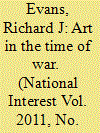

|
|
|
|
|
| Publication |
2011.
|
| Summary/Abstract |
THE LOOTING of artifacts and cultural objects in times of war and violent political upheaval continues to arouse international concern in the twenty-first century just as it did in the twentieth. The plunder of archaeological sites in Egypt during the recent revolution (after they were abruptly abandoned by teams of archaeologists who were understandably concerned about their personal safety) is only the latest example. In Afghanistan and Iraq too, war was followed by the wholesale looting of museums and other sites, and it was not long before plundered objects began to find their way into collections in the West.
|
|
|
|
|
|
|
|
|
|
|
|
|
|
|
|
| 7 |
ID:
155084
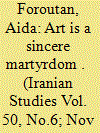

|
|
|
|
|
| Summary/Abstract |
This paper focuses on various aspects of Alireza Espahbod’s style of painting that encrypt his work. The period considered is from the just after the Iranian revolution until the artist’s death in 2007: in these years censorship had become severe, resulting in banning prohibition on his work being exhibited. Apart from the striking symbols that recur throughout his work, it is noticeable that he favors certain visual metaphors for encryption of humanitarian and satirical meanings. The discussion also focuses on the ways in which sequences of his individual paintings create narratives, like scenes in a play or a film. Unlike some preceding modernists, Espahbod is firmly rooted in his Iranian cultural milieu, and is in a line of artists who have used surrealism, beginning with Sadegh Hedayat in the modern literary world. He also follows a much older tradition that goes back to classical poetry and miniature art, in which image and word coalesce and are interchangeable, and where literature and visual art reflect one another. He uses these older techniques to comment allusively on the dramatic events and conditions of his own time. It is argued that his work amounts to more than that of an artist who merely fought against censorship, as his art rises above it and responds to it with a positive message for his audience.
|
|
|
|
|
|
|
|
|
|
|
|
|
|
|
|
| 8 |
ID:
152112
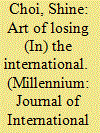

|
|
|
|
|
| Summary/Abstract |
North Korea is an illustrative limit case for exploring contributions of an aesthetic approach to ‘decentering’ IR and taking seriously non-Western subject positions and agencies.1 North Korea is an international problem of human rights, poverty and security that sits across an enemy line, a line where empathy ends and the terrible begins. There are good reasons to condemn, hate and close down our ability to imagine subject positions – the source of life – across this enemy line. Here we can point to its notorious labour reeducation camps and frequent political purges and executions.
|
|
|
|
|
|
|
|
|
|
|
|
|
|
|
|
| 9 |
ID:
177710
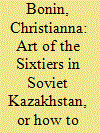

|
|
|
|
|
| Summary/Abstract |
The artists of the Sixtiers generation in Soviet Kazakhstan have typically been understood as the creators of an authentic Kazakh style. This article demonstrates that a web of constructed vectors helped consolidate art as ‘Kazakh’ in the 1960s and early 1970s. I argue that the Sixtiers mined the history of nomadic populations in Central Asia for site-specific cultural forms as a means to connect with an expanding art world and the global context of decolonialization. Neither wholly official nor countercultural, the Sixtiers produced a cultural milieu that stretched the limits of the sayable in late Soviet socialism and defined the margins of modernity with which Kazakh artists continue to contend.
|
|
|
|
|
|
|
|
|
|
|
|
|
|
|
|
| 10 |
ID:
086058
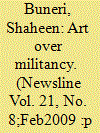

|
|
|
| 11 |
ID:
140052
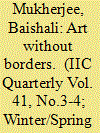

|
|
|
| 12 |
ID:
155473


|
|
|
|
|
| Summary/Abstract |
Art galleries and museums have often been considered as sites at which the international and the political are both enacted and reworked. But how exactly does art ‘do’ geopolitics? Taking existing work on art and geopolitics in the gallery and museum as its departure point, this article advances a specific conceptual argument for how art does geopolitics that connects thinking in this area with broader debates in aesthetics and politics. Building on Jacques Rancière’s account of art as a dispositif, it explores the aesthetic politics – or metapolitics – through which artistic interventions have raised questions of oil within the Tate Galleries in London. Drawing out its ambiguities as well as potential critical implications, the article illustrates distinct ways in which the metapolitics of art may be activated via a discussion of The Robinson Institute, 2012, and of a series of interventions conducted since 2010 by the group Liberate Tate. In conclusion, the article draws out connections between the metapolitics of art and questions of governmentality.
|
|
|
|
|
|
|
|
|
|
|
|
|
|
|
|
| 13 |
ID:
099979
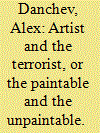

|
|
|
|
|
| Publication |
2010.
|
| Summary/Abstract |
This article is offered as a small demonstration of what art has to say about terror and violence. It focuses on the German artist Gerhard Richter and his cycle of paintings on the life and death of the homegrown terrorists of the Baader-Meinhof group, October 18, 1977 (1988). Following Richter, it explores whether atrocity is "paintable." It investigates the encounter between the artist and the terrorist and proposes that Richter's is a profound exploration of terror and counterterror in the contemporary world.
|
|
|
|
|
|
|
|
|
|
|
|
|
|
|
|
| 14 |
ID:
072521
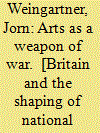

|
|
|
|
|
| Publication |
London, Tauris Academic Studies, 2006.
|
| Description |
viii, 238p.Hbk
|
| Standard Number |
1845110366
|
|
|
|
|
|
|
|
|
|
|
|
Copies: C:1/I:0,R:0,Q:0
Circulation
| Accession# | Call# | Current Location | Status | Policy | Location |
| 051365 | 700.94109044/WEI 051365 | Main | On Shelf | General | |
|
|
|
|
| 15 |
ID:
143657
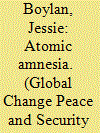

|
|
|
|
|
| Summary/Abstract |
This paper addresses the ways in which photography can illuminate that which is unfathomable, such as nuclear catastrophe. It discusses how chronicling the nuclear era through art can allow us to break free of our atomic amnesia and urge us to imagine possible alternative futures free of nuclear disaster. It examines the ways in which members of the Atomic Photographers Guild have sharply focused on all aspects of the nuclear age and its fallout.
|
|
|
|
|
|
|
|
|
|
|
|
|
|
|
|
| 16 |
ID:
022682
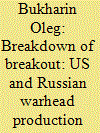

|
|
|
|
|
| Publication |
Oct 2002.
|
| Description |
8-12
|
|
|
|
|
|
|
|
|
|
|
|
|
|
|
|
| 17 |
ID:
147666
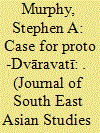

|
|
|
|
|
| Summary/Abstract |
The mid-first millennium CE represents a crucial period in the emergence of early polities in Southeast Asia. However, disagreement remains between archaeologists and art historians as to the precise dating of this shift from prehistory to history. This article focuses on the Dvāravatī period and re-evaluates evidence in Thai and Western language publications. A growing number of sites excavated over the past two decades in particular show occupation from c. the fourth to fifth century onwards while others provide a continual sequence stretching back well into the Iron Age. I argue that evidence from these sites makes a strong case for postulating a proto-Dvāravatī period spanning c. the fourth to fifth centuries. In doing so this article proposes this period as the timeframe within which the nascent traits and characteristics of what becomes Dvāravatī in the seventh to ninth centuries are present and gradually developing.
|
|
|
|
|
|
|
|
|
|
|
|
|
|
|
|
| 18 |
ID:
187262
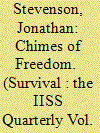

|
|
|
|
|
| Summary/Abstract |
In The Free World: Art and Thought in the Cold War, Louis Menand tests the proposition that the West’s victory in the Cold War might have been a bigger win on the cultural level than it was on the political and military ones. Nuclear dread does not pervade his narrative, and he handles strategic affairs interstitially. During the Cold War, he suggests, the United States and the Soviet Union exploited the human foibles illuminated by modern literature on a grand scale. Visual art, for its part, elevated and framed American capitalism as a cultural as well as an economic monolith. The US government, including the CIA, sought to weaponise Western culture, but Menand concludes that its unaided power was far greater than any government instrument’s. Art may now be less useful or powerful as a tool of cultural warfare than it was in the latter part of the twentieth century.
|
|
|
|
|
|
|
|
|
|
|
|
|
|
|
|
| 19 |
ID:
180357
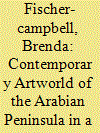

|
|
|
|
|
| Summary/Abstract |
This article analyzes the production and presentation of artworks of three countries of the Gulf Region –– Qatar, the UAE and Saudi Arabia –– to evaluate its place and potential in the globalized artworld. The Gulf region is a small but significant part of the global artworld with high potential for further development. Art globalization in the Gulf began to develop only in the 2000s –– from about 2006 in the UAE, followed by a second wave in Qatar five years later. A third wave is rising with the increasingly international exposure of Saudi Art. The article examines which factors are essential for participation in a globalized art world and whether the region enjoys international recognition on the global stage. A composite artworld ecosystem model comprising institutions, artists and their artworks, commercial entities and government was conceived on a philosophical and sociological basis within a historical and geopolitical framework. The roles of the museum, biennials, art galleries and art fairs, are converging in many respects. All the nodes of the artworld ecosystem are required for globalization, with participation in the biennial model being the most important factor, being more flexible than the museal institutions in funding and programming. To reach a wider audience, the art fair model could be more relevant than the more esoteric biennial format. The Gulf region’s patrons possess strong motivations for supporting the arts of the region internationally. In addition, the desire to enter the global cultural world through the promotion of art museums as a tourist destination is a strong motivator for governments.
|
|
|
|
|
|
|
|
|
|
|
|
|
|
|
|
| 20 |
ID:
148769
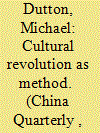

|
|
|
|
|
| Summary/Abstract |
This paper treats the Chinese Cultural Revolution as a means by which to open on to a more affective approach to the question of the political. It examines one piece of art-technology of that period and shows the way it intuitively worked within the fluidity of power to produce political intensity. This one technology is a microcosm of the Cultural Revolution notion of the political that was built around an attempt to channel and harness affective power towards revolutionary ends. Both because it attempts to direct the political through the affective dimension and because its methods of doing so resembled contemporary art practices, this paper opens on to the possibilities of a method based on an art rather than a science of the political.
|
|
|
|
|
|
|
|
|
|
|
|
|
|
|
|
|
|
|
|
|